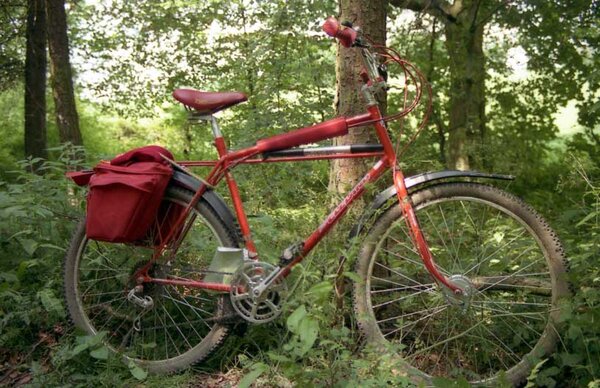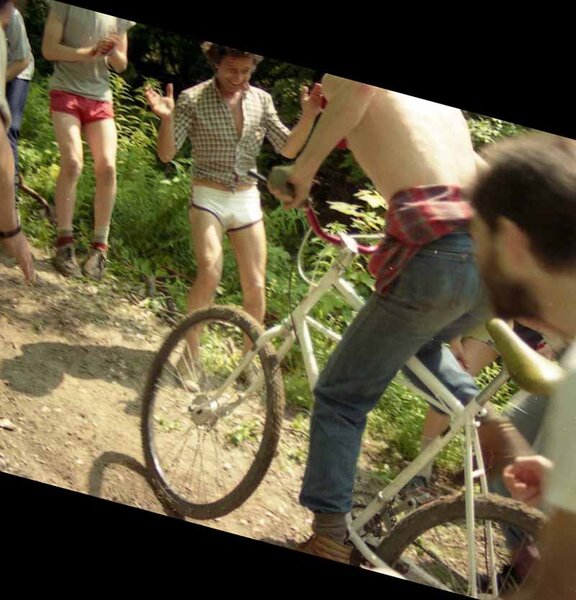Hello Rainard,
That's an astonishingly good restoration job being done on that Aventura!
The rear hub is a very rare Sturmey Archer, there were only twenty five pairs made made in 1986/7. The principle difference is the incorporation of a swing-cam, as per Dave Wrath-Sharman's design. The brake shoes are non-standard, but standard replacement items can be modified to fit. If you're interested, I have a matching front hub, which is part of the Clelandale Prototype, so it's laced into a 590 wheel. I was never very happy with these brakes, they worked very well most of the time, but sometimes would snatch violently, and lock on. And you never knew precisely when this would happen ~ no warning. Some very embarrassing moments. The standard SA (your front hub) were not much use at all in wet and muddy going. Completely unreliable. They may have been improved, but I doubt it. Nowadays, Shimano 'Roller Brakes' fit the bill very well indeed ~ in fact I'd go so far as to say they are as near perfect as you're likely to get.
The Chainset looks completely original, but where did you get those Speed Hakkapeliittas!?!?! They are the best tyres for Cleland style off-roading.
The saddle looks about right for a production model, because the buyer was most likely going to fit their own; you're quite right, a sprung and narrow Brooks, I think the model name was 'Champion'. However, the Cleland concept is ever practical and pragmatic, so, if that saddle is comfortable, then keep in on. However, it looks a little wide to me, because, with the Cleland you are supposed to be able to slide right off the back of the saddle.
And those handlebars won't let you do that, unless you've got very, very long arms! Yep, that handlebar set-up is very definitely not original, and goes against the principles of the Cleland Design; which is...
There is no 'perfect' design layout for a bicycle. People talk about a 'stable' design being desirable. But the fact is that a bicycle is completely unstable; you can't have a stable bicycle, you can only have a bike that is, at times, less unstable. Anyone telling you that their design is stable is talking bollocks. All aspects of bicycle design should take this into account and mitigate the instability. On analysis one can say that the principle means of controlling the instability is by being able to rapidly and easily shift the centre of gravity of the bicycle and rider, but of this combination, the rider is by far the greater part, so shifting the CG of the bike is of little use. The best way of shifting the CG of the rider is to place them on the machine so that their body weight can be readily moved forward or backward, or from side to side, or any combination or permutation of all of these. Placing the handlebar right above the steering axis and relatively near the saddle, with the saddle quite forward, achieves this facility. It also raises the rider to a very high riding position, which makes the CG much higher than the average machine. This flies in the face of conventional design 'wisdom' which says that a low CG is vital for a stable machine. This is simply not true ~ it does apply to vehicles that are inherantly stable (ie: a car) ~ but not to a machinne which falls over if you leave it alone. Here your manipulation of the CG is the rider's principle tool of manoeuvrability. If we see the CG as being at the end of a lever, then the longer that lever is, the less effort is required to manipulate it. The further it is from the ground (the fulcrum) the greater the leverage; you have to move it further, but it is easier to move it.
So, obviously, the previous owner who fitted that handlebar set-up, didn't understand this principle ~ it's like fitting a spoiler to a Range Rover!
The original handlebar was a CW 'Flat Top', but there are some jump bars now available which would fit the bill ~ Gusset 'Prison' for example ~ and using a very short 'BMX' clamp/stem. The Handlebars shown in the Advert were a pair of Renthal Trials bars, and only used on one machine.
Anyway, it will be great to see it completed ~ perhaps you or your father will be able to get over to the Birthday Ride at Wendover next December?





